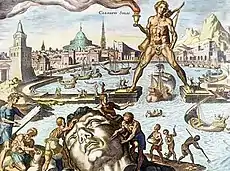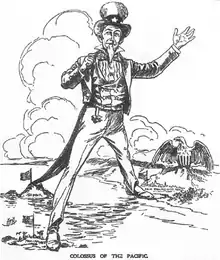The Rhodes Colossus
The Rhodes Colossus is an iconic editorial cartoon published by Punch Magazine in 1892. It alludes to the Scramble for Africa of the New Imperialism period, in which the European powers, beginning in 1884, began the colonisation of Africa by dividing the continent up amongst themselves.
| The Rhodes Colossus | |
|---|---|
 Striding from Cape Town to Cairo. | |
| Artist | Edward Linley Sambourne/Punch Magazine |
| Year | 1892 |
| Subject | Cecil Rhodes |

The image depicts British colonialist Cecil Rhodes as a giant standing over the continent holding a telegraphic line, a reference to his desire to build a "Cape to Cairo" rail and telegraph line and connect the most of the British colonies in Africa.[1]
History
The Rhodes Colossus was drawn by Edward Linley Sambourne, and first appeared in Punch magazine in 1892. It was widely reprinted,[2] and has since become a standard illustration in history texts.[3]
The cartoon was published in the 10 December 1892 edition of Punch, accompanied by a recent excerpt from The Times about a Rhodes plan to extend an electrical telegraph line from Cape Town to Cairo. The excerpt from The Times reads:
Mr. Rhodes announced that it was his intention, either with the help of his friends or by himself, to continue the telegraph northwards, across the Zambesi, through Nyassaland, and along Lake Tanganyika to Uganda. Nor is this all.... This colossal Monte Cristo means to cross the Soudan ... and to complete the overland telegraph line from Cape Town to Cairo; that is, from England to the whole of her possessions or colonies, or 'spheres of influence' in Africa.[4]
The cartoon and excerpt were followed by a piece of satirical verse by Edwin J. Milliken, on the character and ambitions of Rhodes.[3] Satirical verses and stories often accompanied cartoons in Punch magazine.[5] In the verse, Rhodes is described as a "Director and Statesman in one" and a "Seven-League-Booted Colossus" that stands "O'er Africa striding from dark end to end, to forward black emancipation." He is also described as a "shrewd trader" and a "diplomat full of finesse and sharp schemes with a touch of the pious Crusader."[5]
The Rhodes as Colossus pun used in this artwork was a well-known joke that originated in South Africa[3] and that Punch had used before, as well as many others.
Iconography
Edward Linley Sambourne illustrated this visual pun to depict Cecil Rhodes as the ancient Greek statue the Colossus of Rhodes, one of the Seven Wonders of the Ancient World, following the traditional (and architecturally unlikely) depiction of the Colossus with wide-set legs across Rhodes harbour (above).
Rhodes measures with the telegraphic line the distance from Cape Town (at his right foot) in South Africa to Cairo (at his left foot) in Egypt, illustrating his broader "Cape to Cairo" concept for British domination of Africa. In his right hand Rhodes holds a traditional pith helmet with a rifle slung around his right shoulder.
Rhodes stands in a powerful, open armed stance. This is an indication of his power, influence, and attitude towards colonization in Africa. His giant size indicates his larger than life aspirations and desire for dominance over the continent.
Influence

The cartoon is recognized today as a standard illustration in history texts of the Scramble for Africa, and of colonialism as a whole. The original context of a proposed telegraph line is rarely mentioned in such reproductions, which take the "Cape to Cairo" concept more generally.
In Adam Hochschild’s King Leopold’s Ghost: A Story of Greed, Terror, and Heroism, in Colonial Africa, Rhodes is introduced as the “future South African politician and diamond magnate” who claimed he “would annex the planets” if he could.[6]
In 2009, the South African cartoonist Jonathan Shapiro parodied the famous cartoon by placing Chinese premier Wen Jiabao in place of Rhodes holding up Nkosazana Dlamini-Zuma, the then Minister of Foreign Affairs, like a marionette, while the Dalai Lama looks on from Asia.[7] The cartoon satirized Sino-African relations in general, and recent China-South Africa relations in particular, after the Dalai Lama was denied a visa to attend an international peace conference in Johannesburg, a move that was perceived to be the result of Chinese pressure.[8][9]
The Rhodes cartoon also influenced political cartoonist Martin Rowson, who published on 1 February 2013 a drawing[10] in The Guardian on British prime minister David Cameron's policy regarding Algeria and the French intervention in Mali.
Legacy
The cartoon has been used to represent the era of New Imperialism and the Scramble for Africa, as it is a paragon of British Imperialism. Rhodes' legacy in South Africa has been described as "one of the world's most lucrative, and destructive."[11] At times, for example, Rhodes used trickery to coax the local population into signing over territory.[12]
Controversy
There have been documented tensions between colonized and colonizing societies, dating back to the time of New Imperialism.[12] For further reading on controversies surrounding Cecil Rhodes himself, see the Rhodes Must Fall protest movement that emerged in South Africa in 2015 to combat institutional racism.
Bibliography
- Getz, Trevor R., and Heather Streets-Salter. Modern Imperialism and Colonialism: A Global Perspective. Prentice Hall, 2011.
- Hochschild, Adam. King Leopold’s Ghost: A Story of Greed, Terror, and Heroism, in Colonial Africa.[6] New York, NY: Houghton Mifflin Company, 1998.
- Sven Lindqvist, Joan Tate, and Sarah Death. The Dead Do Not Die. New York: The New Press, 2014.[13]
References
- Crossette, Barbara (13 November 1983). "AN AFRICAN JOURNEY, FROM THE CAPE TO CAIRO (Published 1983)". The New York Times. ISSN 0362-4331. Retrieved 21 November 2020.
- Empires, Exceptions, and Anglo-Saxons: Race and Rule between the British and United States Empires, 1880–1910
- Richard Scully, ‘Constructing the Colossus: the Origins of Linley Sambourne’s Greatest Punch Cartoon’, International Journal of Comic Art, Volume 14, No.2, Fall 2012, pp.120–142.
- "Mr. Rhodes and British South Africa". The Times. 30 November 1892. Retrieved 22 October 2020.
- Punch, Volume 103, 10 December 1892
- Hochschild, Adam (1998). King Leopold's Ghost: A Story of Greed, Terror, and Heroism in Colonial Africa. New York, NY: Houghton Mifflin Company. p. 41. ISBN 9780618001903.
- "The Rhodes Colossus - 118 Years Later". Zapiro. 5 April 2009. Retrieved 14 June 2016.
- "Dalai Lama denied visa for South Africa peace conference". CNN. 23 March 2009. Retrieved 21 April 2013.
- "Tibetans blame China for Dalai Lama visa denial". Mail & Guardian. 23 March 2009. Retrieved 21 April 2013.
- "Cameron's African adventure". The Guardian. 1 February 2013. Retrieved 1 February 2013.
- Bond, Patrick (2019). "In South Africa, "Rhodes Must Fall" (While Rhodes' Walls Rise)". New Global Studies. 13(3): 335–350 – via JSTOR.
- Getz, Trevor R.; Streets-Salter, Heather (2011). Modern Imperialism and Colonialism: A Global Perspective. Upper Saddle River, NJ: Pearson Education Inc. pp. 229, 238. ISBN 978-0-321-42409-9.
- Lindqvist, Sven; Tate, Joan; Death, Sarah (2014). The Dead Do Not Die. New York: The New Press. ISBN 9781595589897.
External links
- Punch, 10 December 1892, from Project Gutenberg
- Richard Scully, ‘Constructing the Colossus: the Origins of Linley Sambourne’s Greatest Punch Cartoon’, International Journal of Comic Art, Volume 14, No.2, Fall 2012, pp. 120–142: